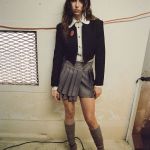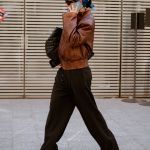
Why fashion can't do without uniforms
From preppy to Miu Miu uniform
May 25th, 2022
Uniform means, paraphrasing the etymology of the term, unique form. It therefore indicates something necessarily recognizable, strongly identity-based and essentially communal. Uniforms serve precisely to create uniforms for a group that recognizes itself in values and customs while simultaneously distancing itself from the views of another. At school, in the office, on the soccer field or elsewhere. Fashion has always drawn on the aesthetic imagery of uniforms precisely because, by its very nature, it thrives on a kind of borderline disorder that now brings it closer to the need to standardize now to the need to differentiate. It is why Raf Simons or Miuccia Prada-just to name a few of the designers linked to the theme-have over time built a super recognizable aesthetic in the form of uniforms that are as conceptual as they are functional.
Or again, and perhaps even more incisively, Thom Browne's work has made the preppy and school uniform become the core of an aesthetic capable of making subversive the mood of an ordinary student grappling with books, pencils, and more or less boring lessons. By a strange affinity with the typical naiveté of rebellion, fashion found a point of contact with everything associated with youth issues in the broadest sense. Hence the success of TV series such as Gossip Girl whose protagonists, in order to be able to endure within a highly classist school scenario and fulfilled only on the surface by a lifestyle marked by the wildest Upper East Side glamour, had to customize their school uniforms. Since 2021, fashion has thus begun to draw heavily on the first decade of the 2000s, triggering a series of only partly overlapping reflections with a Y2K throwback effect. Especially when, in front of Miu Miu's SS22, we were all fascinated by the simplicity with which Miuccia Prada managed to become aware of the fact that there was a need for a fragmentary, light, and edgy uniform to be able to hold its own against the present. Those skimpy miniskirts with cropped sweaters literally cut off meant that the concept of uniform was translated into a fetish dress not without contradictions. The uniform overhaul operation developed further and reached perhaps full maturity in the Miu Miu AW22 collection, distancing itself, however, from the idea of the Catholic collegiate schoolgirl and bringing to the stage a uniform closer to the tennis outfit.
Or, moving on France, Coperni's AW22 show went trawling through the quirks of school uniforms-even the hoodies seem to faithfully reproduce the inner tensions of a teenager forced to go to school-to manage to flush out oddities amid all that uniformity relegated to the comfort of uniforms. Scenario shared (and perhaps even more heartfelt) by Ralph Lauren who, for AW22, imagined bringing to the stage a preppy collegial within the reach of Serena Van Der Woodsen or anyone willing to try their hand at the feat of "dress for the life you want." And how can we not mention, to take up the theme of adolescence and the uniform, the work of Raf Simons who even dedicated an exhibition (the Fourth Sex) to the semantic reservoir ascribable to an age of transition and therefore liable to multifarious interpretations. Here, then, are uniforms and uniforms, so constraining in appearance, becoming true elements of individual expression. Watching a Thom Browne look on one of his employees on the streets of New York or on Oscar Isaac at the Met Gala gives a good idea of how much a uniform turns out to be an interesting stylistic experiment that is as recognizable as it is customizable. It matters little whether the vibe is fetish, glamorous, punk, or erotic: it is the way the fabric of the uniform adheres to our bodies that makes that outfit meaningful.
































































